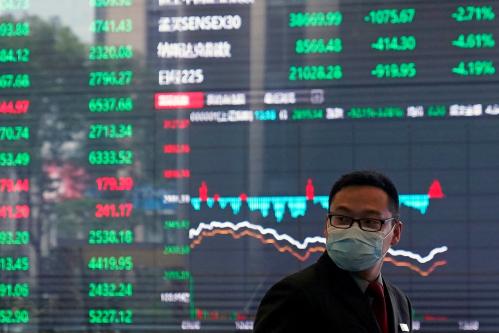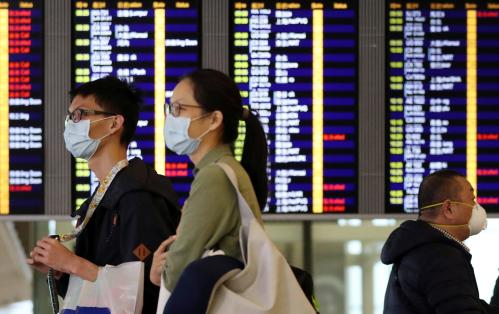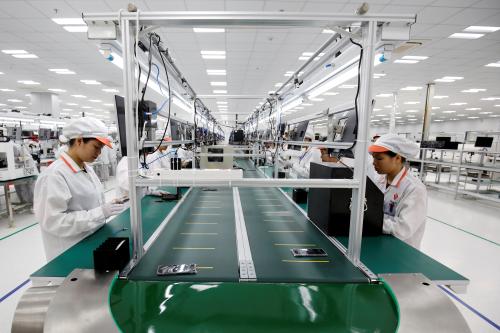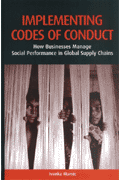The coronavirus is rapidly spreading around the world, threatening to become a global pandemic. At the time of writing, nearly 95,000 people have been infected across 77 countries, while more than 3,200 people have died. While this human toll is undoubtedly the most tragic cost of the disease, the looming economic costs are also beginning to draw attention from policymakers, companies, and investors.
Estimating these costs, however, is extremely difficult: Even if epidemiologists could predict how the virus will evolve and expand, the complex and networked nature of global supply chains makes it all but impossible to precisely unravel how and where economic activity will be impacted.
Decades of deep economic integration have restructured international trade and investment. In modern global value chains, production processes are often spread across dozens of firms operating in multiple countries. The average automobile, for instance, contains about 30,000 parts, and one recent analysis found Toyota relied on 2,192 distinct firms (both direct and indirect suppliers) in its production process. These global value chains have improved economic efficiency, but also introduced new, and unpredictable, vulnerabilities: When any link in the chain breaks, upstream and downstream suppliers and consumers are impacted too. Today many global supply chain networks are becoming so complicated that they are best thought of as complex systems—systems where the cross-cutting relationships between individual units are so dense and convoluted that it is impossible to understand how the system as a whole will react by analyzing its parts. Complex systems tend to exhibit nonlinearity, chain reactions, and feedback loops, which make it difficult to predict how changes to any given unit will impact the broader system.
Because of the network complexity in global supply chains, it may only become clear just how central a particular export hub is upon its sudden failure.
As quarantines shut down individual factories and travel restrictions curb the flow of people and goods, the economic disruption will spread, virus-like, through global supply chains. While several large multinational corporations—such as Best Buy, Nissan, and John Deere—have already warned that restrictions on Chinese production are hitting their supply chains, worse is likely still to come. Built-up inventories—including goods that were already in transit when production halted, but which have only recently arrived in North America and Europe—provided a temporary cushion. But inventories are already stretched thin, and each new supply chain failure will threaten to set off a domino effect in downstream industries. As more and more companies chase fewer and fewer available inputs, shortages and price spikes may result.
The choke points of globalization
The topology of global supply chains—their shape, patterns, and connections—will determine how global production responds to the widespread intermittent supply shocks caused by the coronavirus. Unfortunately, we have only limited knowledge of what exactly this topology looks like. The real threat is that production shutdowns will reveal previously unknown choke points in global economic networks. As the political scientists Henry Farrell and Abraham Newman have recently argued, globalization has not produced a flat, decentralized world economy, but rather a hierarchical, imbalanced network, with critical hubs that exert outsized influence. These hubs can become the choke points of globalization—vital junctures that, when closed off, can severely disrupt economic activity. Identifying exactly where these choke points are, however, is not always obvious ex ante: Because of the network complexity in global supply chains, it may only become clear just how central a particular export hub is upon its sudden failure.
For instance, the coronavirus has already brought attention to the fact that many pharmaceutical companies are highly dependent on active ingredients produced in China. As one analysis noted, “The drug supply chain is opaque and complex—for the most part, consumers and even hospitals can’t find out where their drugs or the ingredients that go into them are made. Even the [Food and Drug Administration] has acknowledged it doesn’t know the amount of drug ingredients being shipped from China.” Of course, relative to most supply chains, the pharmaceutical industry is actually quite highly regulated. If such blind spots exist even in highly regulated industries, similar vulnerabilities in other industries likely have also developed over time, unnoticed by firms, consumers, and regulators. But coronavirus quarantines may expose them.
Shocks to complex systems can sometimes lead actors to uncover better alternatives that, due in part to their inability to process all the options available to them, they had not considered before.
For companies, both the immediate and the longer-term priority is to better understand the vulnerabilities in their production processes, by stress testing their supply chains and planning for potential disruptions. While such practices have always been recommended risk mitigation measures, crises have a way of focusing attention. After the 2011 earthquake in Japan, for instance. Yet the complex nature of global supply chains will make such exercises difficult. To identify weaknesses in their supply chains, companies need to map out not only their immediate suppliers, but also their suppliers’ suppliers and their suppliers’ suppliers’ suppliers. Companies will struggle to acquire and make sense of this much information.
Piecing together the supply chain map
In light of these challenges, there is an important role for governments to play in mapping out today’s supply chains, and the linkages between them. Each firm has only a blinkered, incomplete view of its own little corner of global supply chains—governments must step in to piece together the bigger picture. A better mapping of supply chains will allow policymakers to proactively identify possible choke points in global economic networks, and work to lessen vulnerabilities and introduce strategic redundancies where needed.
Finally, it is worth noting that over the longer term there is at least the potential for some economic benefits from the coronavirus supply shocks. Shocks to complex systems can sometimes lead actors to uncover better alternatives that, due in part to their inability to process all the options available to them, they had not considered before. For instance, when strikes temporarily shut down parts of the London Tube network in February 2014, riders had to experiment to identify new routes to commute to work. After full service was restored, about 5 percent of riders decided to stick with their new commute rather than go back to their pre-strike path—suggesting they’d found an alternative option they preferred to their previous commute. The coronavirus may end up having a similar long-term effect on global supply chains—forced to adopt makeshift measures to overcome a temporary shock, firms may find alternative approaches that serve them better over the long run.









Commentary
The coronavirus will reveal hidden vulnerabilities in complex global supply chains
March 5, 2020